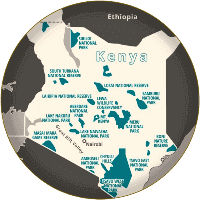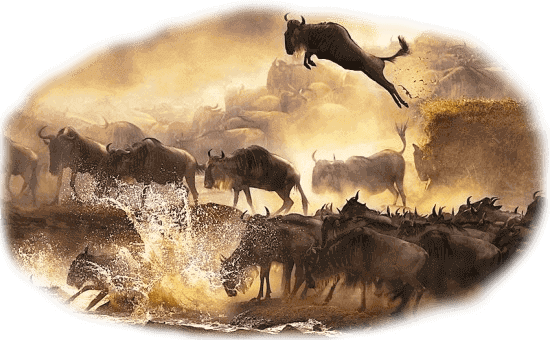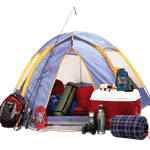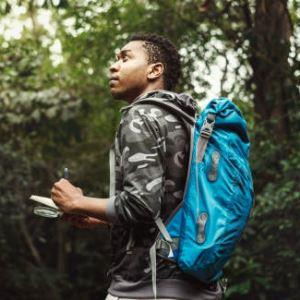 Kenya is one of Africa's premier safari destinations, and for German tourists, it offers an exciting mix of untamed wilderness, iconic wildlife, and vibrant culture. The country boasts a rich variety of ecosystems, including savannahs, forests, wetlands, and mountains, which support a diverse range of animal species. From the majestic lions of the Maasai Mara to the vast elephant herds in Amboseli, there's a thrilling wildlife experience awaiting every traveler. Understanding the seasons is key to planning the perfect safari. Kenya experiences two main dry seasons from June to October and from January to February which are widely regarded as the best times for wildlife viewing. During these periods, the vegetation is thinner, and animals gather around rivers and waterholes, making them easier to spot. These months are also ideal for game drives, as the roads are dry and passable, and most safari lodges are fully operational. The most spectacular wildlife event in Kenya is undoubtedly the Great Migration. Taking place between July and October, millions of wildebeests, zebras, and gazelles cross into the Maasai Mara from Tanzania's Serengeti. This epic journey often includes dramatic river crossings and intense predator-prey interactions, providing an unforgettable experience for photographers and nature lovers alike. While the rainy seasons March to May and November bring lush landscapes and are ideal for birdwatching, they are less popular due to muddy trails and the temporary closure of some camps. However, those who don't mind a little rain can enjoy fewer crowds, lower travel costs, and the chance to witness young animals being born. In addition to its famed national parks like Maasai Mara, Amboseli, and Tsavo, Kenya offers rich cultural encounters and coastal relaxation options. German travelers can easily combine a thrilling safari with a serene beach holiday in places like Diani, Watamu, or Malindi. Convenient domestic flights make it simple to travel between inland reserves and the coast. With direct flights from Germany to Nairobi and Mombasa, Kenya is more accessible than ever. For those planning a trip, the best months for Germans to see wildlife in Kenya are between July and October, when the country showcases its most dramatic natural spectacles. But with its year-round appeal, Kenya truly has something for everyone at any time of the year. Whether you’re a solo adventurer, a couple on a honeymoon, or a family seeking a meaningful vacation, Kenya promises an awe-inspiring encounter with the wild, leaving German visitors with memories that last a lifetime.
Kenya is one of Africa's premier safari destinations, and for German tourists, it offers an exciting mix of untamed wilderness, iconic wildlife, and vibrant culture. The country boasts a rich variety of ecosystems, including savannahs, forests, wetlands, and mountains, which support a diverse range of animal species. From the majestic lions of the Maasai Mara to the vast elephant herds in Amboseli, there's a thrilling wildlife experience awaiting every traveler. Understanding the seasons is key to planning the perfect safari. Kenya experiences two main dry seasons from June to October and from January to February which are widely regarded as the best times for wildlife viewing. During these periods, the vegetation is thinner, and animals gather around rivers and waterholes, making them easier to spot. These months are also ideal for game drives, as the roads are dry and passable, and most safari lodges are fully operational. The most spectacular wildlife event in Kenya is undoubtedly the Great Migration. Taking place between July and October, millions of wildebeests, zebras, and gazelles cross into the Maasai Mara from Tanzania's Serengeti. This epic journey often includes dramatic river crossings and intense predator-prey interactions, providing an unforgettable experience for photographers and nature lovers alike. While the rainy seasons March to May and November bring lush landscapes and are ideal for birdwatching, they are less popular due to muddy trails and the temporary closure of some camps. However, those who don't mind a little rain can enjoy fewer crowds, lower travel costs, and the chance to witness young animals being born. In addition to its famed national parks like Maasai Mara, Amboseli, and Tsavo, Kenya offers rich cultural encounters and coastal relaxation options. German travelers can easily combine a thrilling safari with a serene beach holiday in places like Diani, Watamu, or Malindi. Convenient domestic flights make it simple to travel between inland reserves and the coast. With direct flights from Germany to Nairobi and Mombasa, Kenya is more accessible than ever. For those planning a trip, the best months for Germans to see wildlife in Kenya are between July and October, when the country showcases its most dramatic natural spectacles. But with its year-round appeal, Kenya truly has something for everyone at any time of the year. Whether you’re a solo adventurer, a couple on a honeymoon, or a family seeking a meaningful vacation, Kenya promises an awe-inspiring encounter with the wild, leaving German visitors with memories that last a lifetime.
Kenya Wildlife Safari Seasons & Travel Overview for Germans
| Season | Months | Highlights | Travel Tips for Germans |
|---|---|---|---|
| Dry Season | June - October | Great Migration, Big Five | Ideal for safaris, book early |
| Short Dry | January - February | Big cats, birdwatching | Hot, clear skies, fewer tourists |
| Long Rains | March - May | Lush scenery, fewer crowds | Some lodges close, muddy roads |
| Short Rains | November | Green landscapes, newborn animals | Carry waterproof gear, good photography |
Wildlife Seasons in Kenya: What German Tourists Should Know
Understanding the changing seasons in Kenya is essential for any traveler hoping to make the most of their safari adventure. For German tourists, knowing when to go can mean the difference between a good safari and an unforgettable one. Kenya experiences two main dry seasons, from late June to October and again from January to February. These periods are considered the best for wildlife viewing because the vegetation is sparse, and animals congregate around waterholes, making them easier to spot. The Great Migration is the crown jewel of Kenya's safari experiences. From July to October, over a million wildebeests, zebras, and gazelles make their dramatic river crossings into the Maasai Mara from Tanzania. These months also align conveniently with German summer holidays, making them a perfect window for travel. During this time, German tourists can expect not only to witness this natural wonder but also to see a high concentration of predators like lions, leopards, and cheetahs in action. From January to February, Kenya offers another excellent safari window. This short dry season is ideal for spotting big cats and a wide range of bird species. The weather is hot and dry, providing clear skies and optimal conditions for photography and game drives. With fewer tourists compared to the migration season, it’s a quieter time to enjoy Kenya’s majestic landscapes and abundant wildlife. While the rainy seasons March to May and again in November are less popular for safaris, they bring their own set of advantages. The parks become lush and green, attracting migratory birds and offering a backdrop that’s perfect for photography. It’s also the season when many animals give birth, increasing the chances of spotting young wildlife. However, some camps may close, and roads can become muddy and difficult to navigate. Whether you're looking to travel during peak safari times or prefer a quieter, more intimate experience, planning around the Kenya safari season for German tourists is crucial. Each season offers something unique, and with the right timing, German travelers can enjoy a well-rounded and deeply rewarding wildlife adventure. With Kenya’s extensive network of national parks and domestic flights, it's easy to craft an itinerary that aligns with the seasonal highlights. From the thrilling chases on the Maasai Mara plains to the serene views of Mount Kilimanjaro in Amboseli, the right season will enhance every moment. German tourists should plan ahead, book early during peak times, and stay flexible to make the most of their Kenyan safari experience.
Best Time to See the Great Migration and Big Five in Kenya
One of the most extraordinary spectacles in the animal kingdom is the Great Migration, and Kenya is the ideal destination to witness it in all its raw beauty. For German tourists planning a trip to Africa, timing their safari around this migration can elevate the entire experience. Each year, from July to October, millions of wildebeests, zebras, and gazelles move from Tanzania's Serengeti into Kenya's Maasai Mara National Reserve. This massive movement creates unparalleled opportunities to observe nature at its most dynamic, with predators like lions and crocodiles in pursuit across the Mara River. July marks the beginning of the migration's arrival into Kenya, often with the most thrilling river crossings occurring between late July and August. These scenes are breathtaking: herds crowd at the riverbank, hesitate, and then surge forward, often right into the jaws of waiting predators. September and October are excellent months to observe the wildlife as the herds settle into the Mara before eventually making their return to Tanzania. For German travelers, these months coincide perfectly with summer vacations, making it easier to plan extended trips. Safari lodges in the Maasai Mara fill up quickly during this peak season, so booking well in advance is essential to secure accommodations and guides that can offer the best game-viewing experiences. Outside the migration season, Kenya still offers phenomenal wildlife viewing. From January to February, the weather is warm and dry, making it a great time to see big cats and a variety of birds. These months tend to be less crowded, offering a quieter safari experience while still providing excellent photographic opportunities. During the rainy seasons, from March to May and in November, the landscape transforms into a lush green haven. Although game viewing can be more challenging, the scenery is stunning and fewer tourists mean more intimate encounters with nature. Knowing the Great Migration in Kenya dates for German tourists can make planning much easier and more rewarding. It allows travelers to synchronize their visit with one of the most sought-after wildlife events in the world, all while enjoying Kenya's well-developed tourism infrastructure, including flights, lodges, and guided tours. Incorporating other parks like Amboseli or Tsavo can add variety to the itinerary, giving visitors the chance to experience different terrains and species. Whether it’s the thundering hooves of wildebeests or the tranquil elegance of giraffes, Kenya in migration season is nothing short of magical.
Top Safari Parks in Kenya Every German Traveler Should Visit
Kenya's diverse landscapes and abundant wildlife make it one of the best destinations for a safari holiday, especially for German travelers seeking both adventure and authenticity. With over 40 national parks and game reserves, each offering unique habitats and wildlife species, planning a visit can be both exciting and overwhelming. Fortunately, a thoughtful itinerary can include a range of top parks suited for every travel style and interest. The Maasai Mara National Reserve is undoubtedly the most famous park in Kenya. Known for its vast grasslands and the annual Great Migration, it is the best place to witness large numbers of wildebeests, zebras, and gazelles. The Mara is also excellent for spotting the Big Five: lions, leopards, rhinos, elephants, and buffalo. Many camps in the region cater specifically to international guests, offering guided game drives and cultural visits to Maasai villages. Amboseli National Park is another must-visit, especially for photography lovers. The park is home to large elephant herds and provides stunning views of Mount Kilimanjaro, Africa's tallest peak. Its open plains allow for great visibility, making it easier to spot wildlife and enjoy scenic landscapes. This makes it an ideal location for both seasoned photographers and first-time safari-goers. For a more off-the-beaten-path experience, German travelers might consider Tsavo East and Tsavo West National Parks. Together, they form one of the largest national park systems in the world. These parks are perfect for those who enjoy solitude and wide-open spaces. Tsavo is also rich in birdlife and features a variety of terrains, from lava flows to rivers and dense forests. Lake Nakuru National Park, set around a picturesque soda lake, is renowned for its flamingo population and is a sanctuary for both black and white rhinos. It’s a great stop for wildlife photographers and conservation enthusiasts. Meanwhile, Samburu National Reserve in the north of Kenya offers a different set of species, such as the Grevy's zebra and reticulated giraffe, that are rarely seen in the southern parks. These parks not only provide exceptional wildlife viewing but also offer accommodation options that suit all types of budgets, from luxury lodges to eco-friendly tented camps. Many parks are easily accessible via domestic flights or well-maintained roads, making travel across the country smooth and efficient. This variety and accessibility contribute to what makes the perfect German travel guide for Kenya wildlife experiences whether you're a wildlife enthusiast, a cultural explorer, or a nature-loving photographer, Kenya has something extraordinary to offer year-round.
Must-Visit National Parks and Reserves for German Safari Enthusiasts
Kenya is renowned for its breathtaking wildlife and stunning natural landscapes, making it a top destination for safari lovers. For German tourists seeking a once-in-a-lifetime encounter with Africa's iconic animals, the country's national parks and reserves offer a wide range of experiences. Whether you're eager to see the famous Big Five or explore off-the-beaten-path wilderness, Kenya's parks cater to both first-time visitors and seasoned travelers alike. Below are some of the must-visit locations, along with expanded details to help German safari enthusiasts choose their ideal destination.
- Maasai Mara National Reserve: Located in southwestern Kenya, the Maasai Mara is world-famous for the Great Migration, when millions of wildebeests, zebras, and gazelles traverse the plains from July to October. In addition to this awe-inspiring event, the Mara is a prime location for spotting all members of the Big Five lion, leopard, elephant, buffalo, and rhino. Game drives here offer thrilling encounters with predators and rich cultural interactions with the Maasai people.
- Amboseli National Park: Set against the dramatic backdrop of Mount Kilimanjaro, Amboseli is best known for its large herds of free-roaming elephants. The park's flat terrain and open skies make it ideal for photography, particularly at sunrise and sunset. Visitors can also spot a variety of other wildlife, including giraffes, zebras, and numerous bird species, while enjoying panoramic views of Africa's tallest peak.
- Tsavo National Parks (East and West): These twin parks together form one of the largest protected wilderness areas in the world. Tsavo East is famed for its red-dust elephants and the Galana River, while Tsavo West features rugged terrain, natural springs, and diverse habitats ranging from savannah to volcanic landscapes. Ideal for travelers seeking solitude and less touristic safari experiences, Tsavo offers a sense of raw, untouched Africa.
- Lake Nakuru National Park: Nestled in the Rift Valley, Lake Nakuru is a birdwatcher's paradise. It's particularly famous for its flamingos, which often create a pink hue over the lake. The park is also home to both black and white rhinos, as well as lions and leopards. With its compact size and varied ecosystems, Lake Nakuru makes for a rewarding and manageable safari stop.
- Samburu National Reserve: Located in Kenya's arid north, Samburu offers a unique contrast to the southern parks. It is home to rare northern species known as the "Samburu Special Five": Grevy's zebra, reticulated giraffe, Somali ostrich, gerenuk, and Beisa oryx. This reserve provides a more remote, intimate safari setting and is ideal for travelers looking to see unusual and region-specific wildlife.
Each of these parks features a range of accommodations, from budget-friendly campsites to high-end lodges, ensuring comfort and accessibility for all German travelers. With well-maintained infrastructure and expert guides, these destinations promise unforgettable safari memories.
Combining Beach and Bush: Kenya Itinerary Ideas for Germans
 Kenya is a destination that effortlessly blends the excitement of a wildlife safari with the tranquility of a coastal retreat. For German tourists seeking variety in their travel experience, combining beach and bush offers the best of both worlds. From the sweeping savannahs of the Maasai Mara to the white-sand beaches of Diani, Watamu, or Malindi, Kenya provides a seamless transition from adventure to relaxation. This combination allows travelers to witness breathtaking wildlife in the heart of national parks and then unwind by the turquoise waters of the Indian Ocean. The idea of a bush-and-beach itinerary is especially appealing to German tourists who wish to maximize their travel time and explore Kenya’s diverse landscapes. The convenience of domestic flights and short travel distances makes it easy to craft a well-balanced vacation. A popular itinerary might begin with a week-long safari through iconic parks like the Maasai Mara and Amboseli. These parks offer spectacular game viewing, including the Big Five and, during the migration season, one of nature’s most thrilling events. Accommodations range from rustic lodges to luxury tented camps, each offering unique views and close proximity to wildlife. After days spent tracking elephants and lions, travelers can then fly directly to the coast for a few days of relaxation. Diani Beach is a favorite for its soft sand, coral reefs, and vibrant beach culture. Watamu and Malindi offer more laid-back vibes, ideal for snorkeling, diving, or simply enjoying fresh seafood by the ocean. Luxury options are also available for those who want to indulge. Upscale bush lodges can be paired with private villas or boutique beachfront resorts. Many tour operators offer tailor-made Kenya wildlife tour packages for German tourists that include airport transfers, interconnecting flights, guided safaris, and optional cultural excursions. Families will appreciate the flexibility of combining adventure with downtime. Visiting Nairobi National Park upon arrival gives travelers a taste of wildlife without leaving the capital, while Tsavo National Parks are ideal for a more extended safari leg en route to the coastal towns of Mombasa or Diani. The beach and bush itinerary is ideal for honeymoons, anniversaries, family holidays, or even solo trips. It balances exploration with comfort and creates a well-rounded Kenyan experience. German travelers are increasingly choosing this travel style for its convenience, diversity, and unforgettable moments. Whether watching a lioness with her cubs or relaxing under a palm tree with a cool breeze, the dual experience of Kenya’s wildlife and beaches is nothing short of magical.
Kenya is a destination that effortlessly blends the excitement of a wildlife safari with the tranquility of a coastal retreat. For German tourists seeking variety in their travel experience, combining beach and bush offers the best of both worlds. From the sweeping savannahs of the Maasai Mara to the white-sand beaches of Diani, Watamu, or Malindi, Kenya provides a seamless transition from adventure to relaxation. This combination allows travelers to witness breathtaking wildlife in the heart of national parks and then unwind by the turquoise waters of the Indian Ocean. The idea of a bush-and-beach itinerary is especially appealing to German tourists who wish to maximize their travel time and explore Kenya’s diverse landscapes. The convenience of domestic flights and short travel distances makes it easy to craft a well-balanced vacation. A popular itinerary might begin with a week-long safari through iconic parks like the Maasai Mara and Amboseli. These parks offer spectacular game viewing, including the Big Five and, during the migration season, one of nature’s most thrilling events. Accommodations range from rustic lodges to luxury tented camps, each offering unique views and close proximity to wildlife. After days spent tracking elephants and lions, travelers can then fly directly to the coast for a few days of relaxation. Diani Beach is a favorite for its soft sand, coral reefs, and vibrant beach culture. Watamu and Malindi offer more laid-back vibes, ideal for snorkeling, diving, or simply enjoying fresh seafood by the ocean. Luxury options are also available for those who want to indulge. Upscale bush lodges can be paired with private villas or boutique beachfront resorts. Many tour operators offer tailor-made Kenya wildlife tour packages for German tourists that include airport transfers, interconnecting flights, guided safaris, and optional cultural excursions. Families will appreciate the flexibility of combining adventure with downtime. Visiting Nairobi National Park upon arrival gives travelers a taste of wildlife without leaving the capital, while Tsavo National Parks are ideal for a more extended safari leg en route to the coastal towns of Mombasa or Diani. The beach and bush itinerary is ideal for honeymoons, anniversaries, family holidays, or even solo trips. It balances exploration with comfort and creates a well-rounded Kenyan experience. German travelers are increasingly choosing this travel style for its convenience, diversity, and unforgettable moments. Whether watching a lioness with her cubs or relaxing under a palm tree with a cool breeze, the dual experience of Kenya’s wildlife and beaches is nothing short of magical.
Best Safari and Beach Holiday Combos for German Tourists
Planning a safari and beach holiday in Kenya is one of the most rewarding travel choices German tourists can make. This unique itinerary combines the thrill of game drives with the peace of coastal relaxation, providing a perfect mix of excitement and rest. With a growing number of travelers from Germany looking for immersive, yet relaxing experiences, Kenya offers the ideal destination. From the iconic Maasai Mara to the palm-fringed beaches of Diani and Watamu, there are countless ways to enjoy a memorable Kenyan escape. Particularly during the peak season, Kenya safari holidays from Germany in July and August are increasingly popular due to the alignment with school vacations and the opportunity to witness the Great Migration. Popular itinerary ideas include:
- 7-Day Safari + 5-Day Beach: Start your adventure in Nairobi and head to the Maasai Mara, where you can experience dramatic wildlife encounters including lions, elephants, and wildebeests. After a week of exhilarating game drives and cultural excursions, unwind on the powdery sands of Diani Beach. The contrast between wild savannahs and serene coastlines makes this a balanced and enriching journey.
- Luxury Bush-to-Beach: For travelers who value exclusivity and comfort, this option offers upscale accommodations both in the wilderness and along the coast. Begin your stay at a high-end lodge in the Maasai Mara, where personalized services and gourmet meals elevate the safari experience. Then fly to Watamu or Malindi for a stay in a private beachfront villa with bespoke amenities. This is an ideal choice for honeymooners or couples celebrating special occasions.
- Family-Friendly Combo: Perfect for those traveling with children, this itinerary starts with a visit to Nairobi National Park, which is located just outside the city center and is easily accessible. Continue to Tsavo National Parks for child-friendly lodges and easy wildlife viewing. Finish off the holiday in Mombasa, where family resorts offer a range of kid-focused activities and beach fun.
Kenya's domestic air connections make transitions between the bush and beach swift and seamless, allowing travelers to maximize their time. These thoughtfully crafted combinations give German tourists a holistic view of the country's incredible natural diversity, all within a single, well-structured trip.






